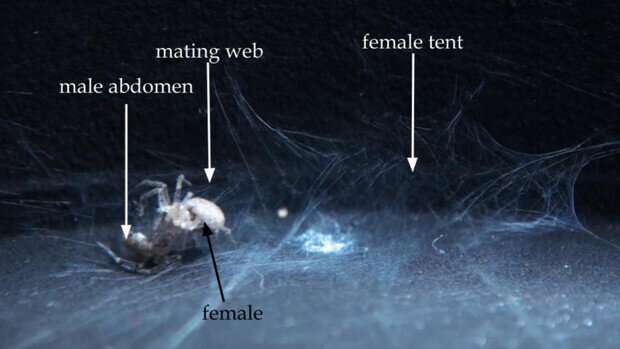Male wall spiders build literal, tubular love nests to court females

Spider courtship boasts some of the most charismatic and strategic rituals in the animal kingdom: bondage worthy of the bedroom, percussive performances worthy of the drumline, silent sounds worthy of tradecraft. Still, arachnologists have documented those rituals in only a tiny fraction of the known 50,000-plus spider species, which hail from more than 100 families. Of the species whose courtships have been studied, most fall within just a few of those families, limiting how much arachnologists can glean about the evolution of mating across spiders as a whole.
Alongside colleagues based in Brazil and Costa Rica, Nebraska’s Laura Segura Hernández helped catalog the courtship and copulation of Oecobius concinnus, a species of wall spider that inhabits the tropics and subtropics of South, Central and North America.
The team collected 24 O. concinnus—13 female, 11 male—from Costa Rica, placed each female in a petri dish large enough for her to build a circus tent-like web, then introduced her to a male. As part of a courtship routine that lasted an average of almost an hour, males proceeded to construct tubular webs beneath the female’s tent.
When females did consent to mating, the team found, it usually took place inside that tubular structure. The researchers speculated that males might build the love nest for two reasons:
- Providing a platform on which to deposit pheromone-coated threads that might entice a female to mate.
- Constricting the movement of the female—potentially limiting her ability to attack or pursue the smaller male, as she sometimes will beyond the confines of the tubular web.

Segura Hernández and her colleagues observed two mating positions, both of which differed from those reported in closely related species. They also described and quantified multiple courtship behaviors, using statistical analyses to determine that 25% of those behaviors were coupled more often than would be expected by chance. That suggests the behaviors were not random, the team said, and may help signal the worthiness of the male, stimulate female interest, or at least reduce her aggression.
The paper is published in the journal Arachnology.
Confirming the proposed purposes of the tubular web will require further study, the researchers said. Running experiments with virgin O. concinnus, meanwhile, could help untangle whether the most frequent courtship behaviors are honed by prior sexual experiences.
More information:
Diego Solano-Brenes et al, Description of the courtship and copulation behaviours of the wall spider Oecobius concinnus (Oecobiidae), Arachnology (2022). DOI: 10.13156/arac.2022.19.3.597
Citation:
Male wall spiders build literal, tubular love nests to court females (2023, February 7)
retrieved 7 February 2023
from https://phys.org/news/2023-02-male-wall-spiders-literal-tubular.html
This document is subject to copyright. Apart from any fair dealing for the purpose of private study or research, no
part may be reproduced without the written permission. The content is provided for information purposes only.
For all the latest Science News Click Here
For the latest news and updates, follow us on Google News.

